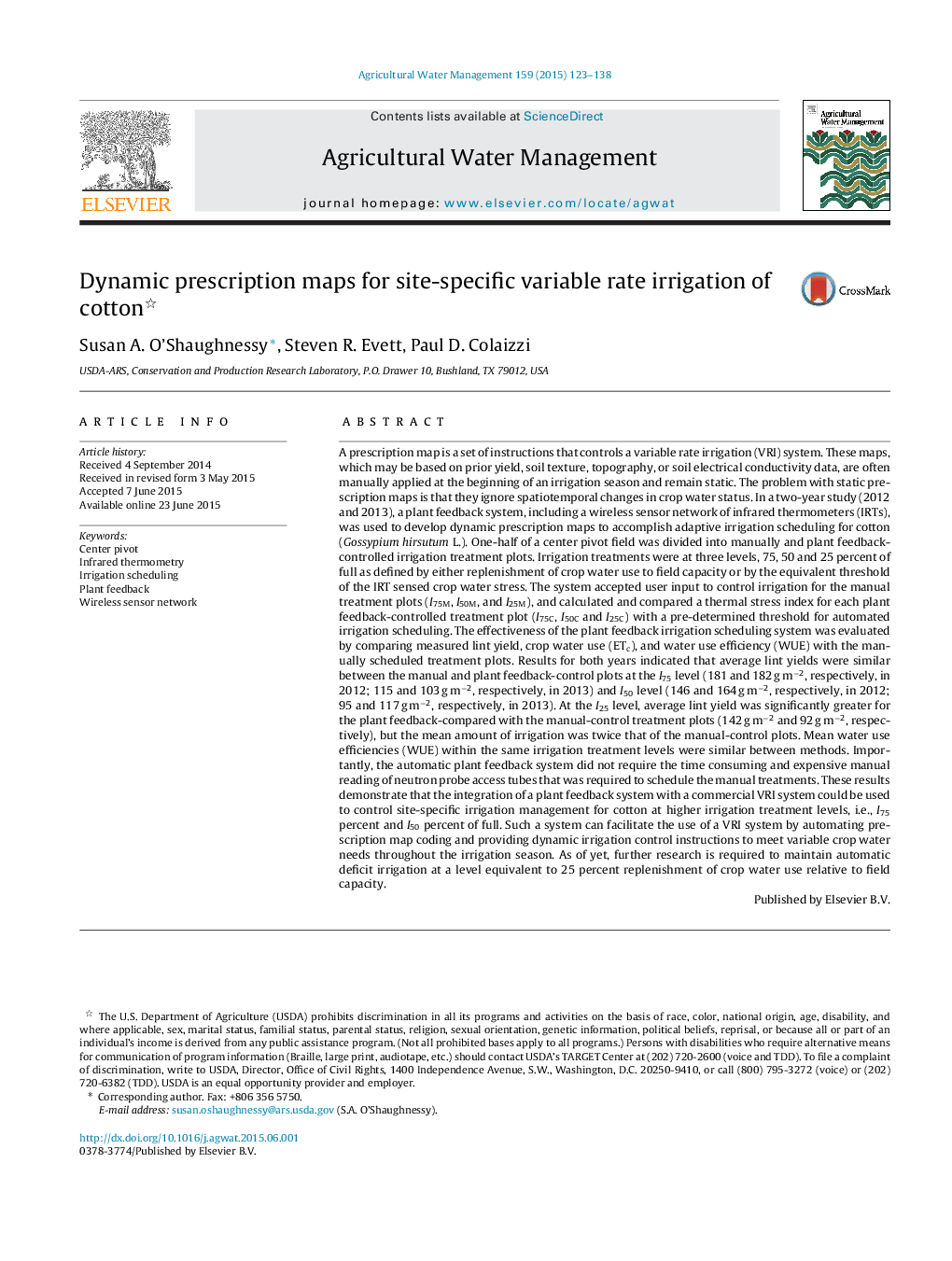| کد مقاله | کد نشریه | سال انتشار | مقاله انگلیسی | نسخه تمام متن |
|---|---|---|---|---|
| 6363707 | 1622920 | 2015 | 16 صفحه PDF | دانلود رایگان |
عنوان انگلیسی مقاله ISI
Dynamic prescription maps for site-specific variable rate irrigation of cotton
ترجمه فارسی عنوان
نقشه های پویا برای آبیاری تغییر متغیر نرخ بذر پنبه
دانلود مقاله + سفارش ترجمه
دانلود مقاله ISI انگلیسی
رایگان برای ایرانیان
کلمات کلیدی
محور مرکز، ترمومتر مادون قرمز، برنامه ریزی آبیاری، بازخورد گیاهی، شبکه حسگر بی سیم،
موضوعات مرتبط
علوم زیستی و بیوفناوری
علوم کشاورزی و بیولوژیک
علوم زراعت و اصلاح نباتات
چکیده انگلیسی
A prescription map is a set of instructions that controls a variable rate irrigation (VRI) system. These maps, which may be based on prior yield, soil texture, topography, or soil electrical conductivity data, are often manually applied at the beginning of an irrigation season and remain static. The problem with static prescription maps is that they ignore spatiotemporal changes in crop water status. In a two-year study (2012 and 2013), a plant feedback system, including a wireless sensor network of infrared thermometers (IRTs), was used to develop dynamic prescription maps to accomplish adaptive irrigation scheduling for cotton (Gossypium hirsutum L.). One-half of a center pivot field was divided into manually and plant feedback-controlled irrigation treatment plots. Irrigation treatments were at three levels, 75, 50 and 25 percent of full as defined by either replenishment of crop water use to field capacity or by the equivalent threshold of the IRT sensed crop water stress. The system accepted user input to control irrigation for the manual treatment plots (I75M, I50M, and I25M), and calculated and compared a thermal stress index for each plant feedback-controlled treatment plot (I75C, I50C and I25C) with a pre-determined threshold for automated irrigation scheduling. The effectiveness of the plant feedback irrigation scheduling system was evaluated by comparing measured lint yield, crop water use (ETc), and water use efficiency (WUE) with the manually scheduled treatment plots. Results for both years indicated that average lint yields were similar between the manual and plant feedback-control plots at the I75 level (181 and 182 g mâ2, respectively, in 2012; 115 and 103 g mâ2, respectively, in 2013) and I50 level (146 and 164 g mâ2, respectively, in 2012; 95 and 117 g mâ2, respectively, in 2013). At the I25 level, average lint yield was significantly greater for the plant feedback-compared with the manual-control treatment plots (142 g mâ2 and 92 g mâ2, respectively), but the mean amount of irrigation was twice that of the manual-control plots. Mean water use efficiencies (WUE) within the same irrigation treatment levels were similar between methods. Importantly, the automatic plant feedback system did not require the time consuming and expensive manual reading of neutron probe access tubes that was required to schedule the manual treatments. These results demonstrate that the integration of a plant feedback system with a commercial VRI system could be used to control site-specific irrigation management for cotton at higher irrigation treatment levels, i.e., I75 percent and I50 percent of full. Such a system can facilitate the use of a VRI system by automating prescription map coding and providing dynamic irrigation control instructions to meet variable crop water needs throughout the irrigation season. As of yet, further research is required to maintain automatic deficit irrigation at a level equivalent to 25 percent replenishment of crop water use relative to field capacity.
ناشر
Database: Elsevier - ScienceDirect (ساینس دایرکت)
Journal: Agricultural Water Management - Volume 159, September 2015, Pages 123-138
Journal: Agricultural Water Management - Volume 159, September 2015, Pages 123-138
نویسندگان
Susan A. O'Shaughnessy, Steven R. Evett, Paul D. Colaizzi,
